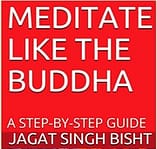A Lifetime’s Practice
You have successfully completed a structured journey for beginning, establishing, strengthening, and consolidating your meditative practice. This guide has provided a step-by-step approach, ensuring clarity and depth at every stage.
Meditation is not merely something to be learned and set aside—it is a lifetime’s practice. The instructions in this series have been compiled based on years of self-practice and experience in guiding individuals and groups. If followed diligently, they will provide a strong foundation for lifelong mindfulness and inner peace.
How to Progress Through the Series
This series has been carefully designed with small, structured steps to help you build your meditative practice progressively. To ensure maximum benefit, follow these guidelines:
- Step-by-Step Mastery
- Begin with The First Step, focusing on a stable and comfortable sitting posture.
- Spend 10 to 15 minutes daily in this posture until you feel completely at ease.
- Some may take a few days, others longer—there is no rush.
- Watching the Breath
- Move to the next step, Watch Your Breath, only when fully confident in your posture.
- Simply observe your breath:
- Ever mindful, breathe in. Mindful, breathe out.
- This is the most fundamental step—take your time with it. Only when fully comfortable should you proceed further.
- Advancing Through the Stages
- Follow the lessons in sequence, ensuring each step is well-practised before moving ahead.
- Some steps may need to be repeated for several days—this is normal.
- Do not rush; progress only when you feel ready and confident.
- Cumulative Practice
- As you move forward, always begin with the first steps before introducing new ones.
- Over time, earlier steps will require less attention, allowing more focus on new techniques.
- Developing a Daily Routine
- Start with 10 to 15 minutes of practice and gradually increase the duration.
- Aim for at least an hour of daily meditation once all steps have been completed.
- Meditation is not a one-time learning experience but an ongoing journey of self-discovery.
Deepening Your Practice
- Once you reach A Summary of the Steps, consider revisiting earlier lessons for further refinement.
- Repeating the series slowly and steadily will deepen your understanding and experience.
- Over time, what may have seemed monotonous at first will transform into a joyful and enriching experience.
Meditation, when practiced regularly, becomes an integral part of life—bringing peace, clarity, and happiness.
Go ahead and enjoy your voyage into the realm of calm!
♥ ♥ ♥ ♥
Please click on the following links to read previously published posts “Meditate Like The Buddha: A Step-By-Step Guide” 👉
☆ Meditate Like The Buddha #1: A Step-By-Step Guide ☆ Mr. Jagat Singh Bisht ☆
☆ Meditate Like The Buddha #2: The First Step ☆ Mr. Jagat Singh Bisht ☆
☆ Meditate Like The Buddha #3: Watch Your Breath ☆ Mr. Jagat Singh Bisht ☆
☆ Meditate Like The Buddha #4: Relax Your Body ☆ Mr. Jagat Singh Bisht ☆
☆ Meditate Like The Buddha #5: Cultivate Loving kindness ☆ Mr. Jagat Singh Bisht ☆
☆ Meditate Like The Buddha # 6: Experience your feelings ☆ Mr. Jagat Singh Bisht ☆
☆ Meditate Like The Buddha # 7: Tranquilize Mental Formations☆ Mr. Jagat Singh Bisht ☆
English Literature – Articles ☆ Meditate Like The Buddha # 8: Midway Recap ☆ Mr. Jagat Singh Bisht ☆
© Jagat Singh Bisht
Laughter Yoga Master Trainer
FounderLifeSkills
A Pathway to Authentic Happiness, Well-Being & A Fulfilling Life! We teach skills to lead a healthy, happy and meaningful life.
The Science of Happiness (Positive Psychology), Meditation, Yoga, Spirituality and Laughter Yoga. We conduct talks, seminars, workshops, retreats and training.
≈ Editor – Shri Hemant Bawankar/Editor (English) – Captain Pravin Raghuvanshi, NM












